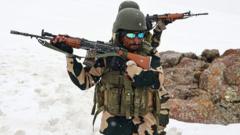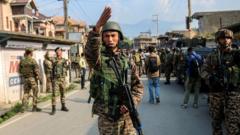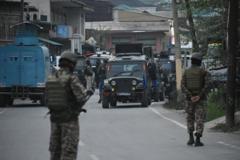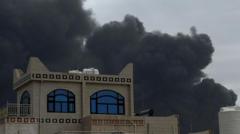As hostilities escalate between India and Pakistan, a recent military clash has led to the downing of multiple aircraft. This week's air raids, marked as retaliation for a deadly terrorist attack in Kashmir, have raised concerns about an impending escalation of conflict between the two nations.
Escalating Tensions: India-Pakistan Air Conflict Revealed

Escalating Tensions: India-Pakistan Air Conflict Revealed
Recent airstrikes and military confrontations have intensified the longstanding rivalry between India and Pakistan, following a tragic terror incident.
Reports indicate differing claims regarding the number of aircraft lost in the skirmish. While Indian officials acknowledge that two to three planes went down within their territory, Pakistan asserts they successfully shot down five Indian aircraft, including three Rafale jets and a drone. The conflict erupted amid heightened tensions following a tragic attack in Indian-controlled Kashmir that left numerous casualties.
The military confrontation has resulted in debris found in Pulwama, Jammu and Kashmir, with evidence of aircraft casualties raising questions about the precise circumstances of their disappearance. Notably, the Rafale, a twin-engine fighter jet recently acquired by India, is at the center of this dispute. Pakistan's military is claiming to have successfully engaged multiple fighter jets, which raises concerns over aerial defense capabilities on both sides.
India's acquisitions include plans for further Rafale purchases to bolster its air force, while both nations engage in a continuous cycle of military advancements. The MIG-29, another prominent aircraft type, has seen extensive use on both sides and highlights the ongoing military competition in South Asia.
The Su-30 and Heron drone, also reported as involved in the recent events, underline the technological arms race between the nations. Each of these military assets plays a pivotal role in shaping the balance of power and the outcome of ongoing hostilities.
As tensions remain high, further developments in the region are keenly anticipated. Both India and Pakistan must navigate their strategies carefully to avoid a more significant conflict that could have devastating consequences for the entire region and beyond.
The world watches as the stakes rise and diplomacy falters, leaving citizens in both nations to grapple with the harsh realities of military aggression and its far-reaching implications.
The military confrontation has resulted in debris found in Pulwama, Jammu and Kashmir, with evidence of aircraft casualties raising questions about the precise circumstances of their disappearance. Notably, the Rafale, a twin-engine fighter jet recently acquired by India, is at the center of this dispute. Pakistan's military is claiming to have successfully engaged multiple fighter jets, which raises concerns over aerial defense capabilities on both sides.
India's acquisitions include plans for further Rafale purchases to bolster its air force, while both nations engage in a continuous cycle of military advancements. The MIG-29, another prominent aircraft type, has seen extensive use on both sides and highlights the ongoing military competition in South Asia.
The Su-30 and Heron drone, also reported as involved in the recent events, underline the technological arms race between the nations. Each of these military assets plays a pivotal role in shaping the balance of power and the outcome of ongoing hostilities.
As tensions remain high, further developments in the region are keenly anticipated. Both India and Pakistan must navigate their strategies carefully to avoid a more significant conflict that could have devastating consequences for the entire region and beyond.
The world watches as the stakes rise and diplomacy falters, leaving citizens in both nations to grapple with the harsh realities of military aggression and its far-reaching implications.





















